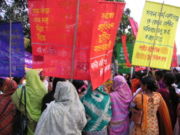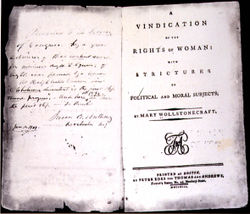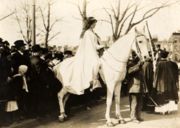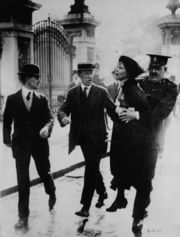Women's rights
2008/9 Schools Wikipedia Selection. Related subjects: Animal & Human Rights
| Rights |
| Animal rights |
| Children's rights |
| Civil and political rights |
| Fathers' rights |
| Gay rights |
| Group rights |
| Human rights |
| Inalienable rights |
| Individual rights |
| Legal rights |
| Men's rights |
| Natural right |
| Negative & positive |
| Claims & liberties |
| Reproductive rights |
| Right of self-defense |
| Economic, social and cultural rights |
| "Three generations" |
| Women's rights |
| Workers' rights |
| Youth rights |
The term women’s rights refers to the freedoms inherently possessed by women and girls of all ages, which may be institutionalized, ignored or suppressed by law, custom, and behaviour in a particular society. These liberties are grouped together and differentiated from broader notions of human rights because they often differ from the freedoms inherently possessed by or recognized for men and boys, and because activism surrounding this issue claims an inherent historical and traditional bias against the exercise of rights by women.
Some of the issues commonly associated with these notions include rights to:
- bodily integrity and autonomy;
- vote (universal suffrage);
- hold public office;
- work;
- fair wages or equal pay;
- own property and to enter into legal contracts;
- education;
- serve in the military; and
- to have marital, parental and religious rights.
Activists have campaigned, and in some places continue to campaign, for the same rights as modern men.
A history of women's rights
Historical background
Till the mid nineteenth century, writers assumed that a patriarchal order was a natural order that had existed as JS Mill wrote, since "the very earliest twilight of human society". This was not seriously challenged till the eighteenth century when Jesuit missionaries found matrilineality in native North American peoples.
In the 16th century, the Reformation allowed more women to add their voices, including the English writers Jane Anger, Aemilia Lanyer, and the prophetess Anna Trapnell. However, it has been claimed that the Dissolution and resulting closure of convents had deprived many such women of one path to education. Giving voice in the secular context became more difficult when deprived of the rationale and protection of divine inspiration. Queen Elizabeth I demonstrated leadership amongst women, even if she was unsupportive of their causes, and subsequently became a role model for the education of women.
The Enlightenment and A Vindication of the Rights of Woman
The Age of Enlightenment was characterized by secular intellectual reasoning, and a flowering of philosophical writing. The most important feminist writer of the time was Mary Wollstonecraft, often described as the first feminist philosopher. A Vindication of the Rights of Woman (1792). Wollstonecraft argued that it was the education and upbringing of women that created limited expectations. Despite some inconsistencies (Brody refers to the "Two Wollestoncrafts" ) reflective of problems that had no easy answers, this book remains a foundation stone of feminist thought.
In other parts of Europe, Hedvig Charlotta Nordenflycht was writing in Sweden, and what is thought to be the first scientific society for women was founded in Middelburg, in the south of Holland in 1785. This was the Natuurkundig Genootschap der Dames (Women's Society for Natural Knowledge). which met regularly until 1881, finally dissolving in 1887. However Deborah Crocker and Sethanne Howard point out that women have been scientists for 4,000 years. Journals for women which focused on science became popular during this period as well.
Suffrage, the right to vote
The ideas that were planted in the late 1700s took root during the 1800s. Women began to agitate for the right to vote and participate in government and law making. The ideals of Women's suffrage developed alongside that of universal suffrage, and women's movements took lessons from those in other countries.
United States
American women advocated women's right to vote from the 1820s onward. This was first achieved in the relatively sparsely-populated territories of Wyoming (1869) and briefly in Utah (1870), although Utah women were disenfranchised by the U.S. Congress in 1887. The push to grant Utah women's suffrage was at least partially fueled by outsiders' belief that, given the right to vote, Utah women would dispose of polygamy. After Utah women exercised their suffrage rights in favour of polygamy the U.S. Congress disenfranchised Utah women. Other territories and states granted women the right to vote in the late 19th and early 20th century, but national women's suffrage did not come until the Nineteenth Amendment to the United States Constitution was ratified in 1920.
US timeline
- 1848 - The first Women's Rights Convention ( Seneca Falls Convention) is held in Seneca Falls, NY
- 1849 - Women doctors are now permitted to legally practice medicine
- Elizabeth Blackwell (doctor) becomes the first female to receive a medical degree in the United States
- 1852 - Susan B. Anthony and Elizabeth Cady Stanton form the Women's New York Temperance Society
- 1860-1865 - American Civil War
- 1868 - The Fourteenth Amendment to the United States Constitution is ratified
- 1869 - Lucy Stone , Henry Blackwell , and Julia Ward Howe are instrumental in forming the American Woman Suffrage Association
- 1872 - Susan B. Anthony is arrested for attempting to vote
- 1890 - Wyoming becomes the first state to allow women to vote
- 1920 - The Nineteenth Amendment to the United States Constitution is ratified
United Kingdom
Throughout the 19th century British women reformers developed their own dialogue through many various reforming groups until, by 1903, they had formed into two distinct organisations; the democratic National Union of Women's Suffrage Societies, and the militant Women's Social and Political Union. Leaders in the struggle were the peaceful Millicent Fawcett and radical Emmeline Pankhurst with her daughter Christabel. Their fight also proved slow and frustrating. In 1918 the British Parliament finally passed a bill allowing women over the age of 30 to vote. In 1928 the age limit was lowered to 21.
Other countries
In some nations women were granted full voting rights earlier than in the United States and Britain. Women first won the right to vote in New Zealand in 1893, Australia in 1902, and Finland in 1906. But many other nations proved much slower to change. For example, women in France were not given voting rights until 1944. However, in some of these countries only women in the ruling population were able to vote at first. For example, Aboriginal women in Australia were not allowed to vote until they became citizens in 1967.
Today women in some conservative Arab countries still do not have the right to vote, or barely any rights at all.
The modern movement
In the subsequent decades women's rights again became an important issue in the English speaking worlds. By the 1960s the movement was called “feminism” or “women's liberation.” Reformers wanted the same pay as men, equal rights in law, and the freedom to plan their families or not have children at all. Their efforts were met with mixed results.
In the UK a public groundswell of opinion in favour of legal equality had gained pace, partly through the extensive employment of women in men's traditional roles during both world wars. By the 1960s the legislative process was being readied, tracing through MP Willie Hamilton's select committee report, his Equal Pay For Equal Work Bill, the creation of a Sex Discrimination Board, Lady Sear's draft sex anti-discrimination bill, a government Green Paper of 1973, until 1975 when the first British Sex Discrimination Act, an Equal Pay Act, and an Equal Opportunities Commission came into force. With encouragement from the UK government, the other countries of the EEC soon followed suit with an agreement to ensure that discrimination laws would be phased out across the European Community.
In the USA, the US National Organization of Women (NOW) was created in 1966 with the purpose of bringing about equality for all women. NOW was one important group that fought for the Equal Rights Amendment (ERA). This amendment stated that “equality of rights under the law shall not be denied or abridged by the United States or any state on account of sex.” But there was disagreement on how the proposed amendment would be understood. Supporters believed it would guarantee women equal treatment. But critics feared it might deny women the right be financially supported by their husbands. The amendment died in 1982 because not enough states had ratified it. ERAs have been included in subsequent Congressses, but have still failed to be ratified.
In the last three decades of the 20th century, Western women knew a new freedom through birth control, which enabled women to plan their adult lives, often making way for both career and family. The movement had been started in the 1910s by US pioneering social reformer Margaret Sanger and in the UK and internationally by Marie Stopes.
Over the course of the 20th century women took on a greater role in society. For example, many women served in government. In the U.S. government some served as U.S. Senators and others as members of the U.S. Cabinet. Many women took advantage of opportunities to become educated. In the United States at the beginning of the 20th century less than 20 percent of all college degrees were earned by women. By the end of the century this figure had risen to about 50 percent.
Opportunities also expanded in the workplace. Fields such as medicine, law, and science opened to include more women. At the beginning of the 20th century about 5 percent of the doctors in the United States were women. As of 1998, 23 percent of all doctors were women, and today, women make up more than 50 percent of the medical student population. While the numbers of women in these fields increased, many women still continued to hold clerical, factory, retail, or service jobs. For example, they worked as office assistants, on assembly lines, or as cooks.
US timeline
- 1931-1945 - World War II
- 1960 - Margaret Sanger opens the first U.S. birth-control clinic in Brooklyn, NY (The clinic was shut down ten days later and Sanger was arrested)
- 1960 - The FDA approves birth-control pills
- 1963 - Congress passes the Equal Pay Act
- 1966 - The National Organization for Women is founded
- 1970 - 50,000 people march in New York City for the first women's Strike for Equality
- 1971 - United States Supreme Court rule ends sex discrimination in hiring
- 1981 - Sandra Day O'Connor becomes the first female justice
- 1997 - Madeleine Albright becomes the first female United States Secretary of State
- 2005 - Condoleezza Rice becomes the first female African American Secretary of State
The United Nations and women's rights
In 1946 the United Nations established a Commission on the Status of Women. Originally as the Section on the Status of Women, Human Rights Division, Department of Social Affairs, and now part of the Economic and Social Council (ECOSOC). In 1948 the UN issued its Universal Declaration of Human Rights which protects "the equal rights of men and women", and addressed both the equality and equity issues.

Since 1975 the UN has held a series of world conferences on women's issues, starting with the World Conference of the International Women's Year in Mexico City. These conferences created an international forum for women's rights, but also illustrated divisions between women of different cultures and the difficulties of attempting to apply principles universally Emerging from the 1985 Nairobi conference was a realization that feminism is not monolithic but "constitutes the political expression of the concerns and interests of women from different regions, classes, nationalities, and ethnic backgrounds. There is and must be a diversity of feminisms, responsive to the different needs and concerns of women, and defined by them for themselves. This diversity builds on a common opposition to gender oppression and hierarchy which, however, is only the first step in articulating and acting upon a political agenda." At the Fourth World Conference on Women in Beijing, The Platform for Action was signed. This included a commitment to achieve " gender equality and the empowerment of women".
Reproductive rights
Reproductive rights are rights relating to sexual reproduction and reproductive health. The idea of these rights were first discussed as a subset of human rights at the United Nation's 1968 International Conference on Human Rights. The sixteenth article of the Proclamation of Teheran states, "Parents have a basic human right to determine freely and responsibly the number and the spacing of their children." Since then, reproductive rights have been established as human rights in international human rights documents, particularly with the ratification of the Convention to End Discrimination Against Women ( CEDAW), and the adoption of the the Cairo Programme and the Beijing Platform. Reproductive rights are often held to include the right to control one's reproductive functions, the right to access quality reproductive healthcare, the right to education and access in order to make reproductive choices free from coercion, discrimination, and violence.


